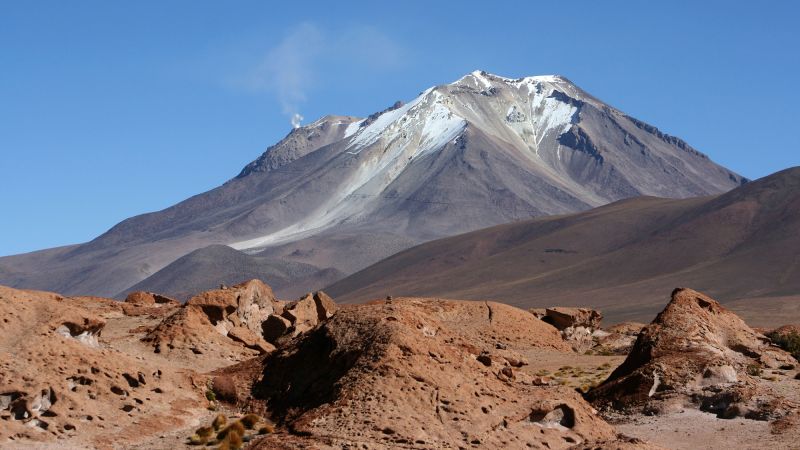**Exploring the Awakening of a “Zombie Volcano” in the Andes**
As the quest for scientific understanding marches forward, many unique geological phenomena capture researchers’ imaginations; one such entity is the famed “zombie volcano,” a moniker fittingly applied to the Uturuncu. Nestled within the Central Andes mountain range, this notable peak has remained dormant for over 250,000 years. Yet, it surprisingly exhibits signs of geological activity akin to its more vivacious volcanic counterparts. Evidence of gas plumes and tectonic shifts like earthquakes hints at the possibility that this seemingly inactive volcano may very well be awakening from its long slumber.
In recent studies utilizing satellite radar imagery—gathered over two decades—scientists pinpointed significant geological shifts in Uturuncu. The imagery revealed a dramatic uplift and subsequent subsidence of a region approximately 93 miles (150 kilometers) in diameter near the summit of the volcano; its unique profile has even drawn comparisons to the traditional shape of a sombrero. Motivated to decipher whether the ongoing geological disturbances are early warning signs of reawakening, a team of researchers undertook an extensive examination of Uturuncu.
To obtain a comprehensive analysis of the volcano, scientists synthesized satellite data with insights gleaned from seismic activity and computer-generated models that simulate the behavior of rocks under varying pressures. The results, published in the journal *Proceedings of the National Academy of Sciences* on April 28, confirmed prior suspicions regarding Uturuncu’s unrest. Traditionally, volcanic eruptions are attributable to magma accumulating in designated chambers beneath the surface, which then escapes through fractures and vents, resulting in explosive events. However, the situation under Uturuncu diverges from this norm.
Rather than a straightforward rise of magma, the study unearthed a complex hydrothermal system where magma, gases, and saline fluids engage with one another. This interaction has engendered the perpetual rumblings characteristic of this “zombie.” Particularly striking is the existence of the Altiplano-Puna Magma Body, a colossal reservoir located approximately 6 to 12 miles (10 to 20 kilometers) beneath the surface, sprawling across 124 miles (200 kilometers). Previous investigations had indicated a presence of hydrothermal activity linking this vast magma reservoir to the above-ground features of the mountain range, yet the intricate dynamics of this subterranean system remained cryptic until now.
Over 1,700 seismic events recorded between 2009 and 2012 allowed scientists to construct high-resolution models of the shallow geological landscape underlying Uturuncu. Furthermore, shifts in electrical conductivity and gravity, in conjunction with variations in rock chemistry, provided enhanced details regarding the movement of thermally heated fluids through the volcanic structure. The findings indicated that as heat from the magma body causes the subterranean liquids to boil and release gas, these elements migrate upward, accumulating in chambers beneath the volcano’s apex. This activity precipitates earthquakes, releases steam, and instigates deformation of the rocks, with measurements indicating an upward surface displacement of approximately 0.4 inches (1 centimeter) each year.
Despite these signs of activity, researchers caution against interpreting them as precursors to an imminent eruption. Dr. Mike Kendall, a professor and head of the Earth Sciences Department at the University of Oxford, emphasized that the lack of escalating seismic activity suggests a more subdued state for Uturuncu. An increase in earthquakes is a typical warning sign signaling magma’s ascent toward the surface; however, the current data indicate a scenario wherein the volcano is merely “degassing” off steam, illustrating a cessation rather than a heightening of volcanic activity.
The multifaceted techniques employed to elucidate Uturuncu’s subsurface structure were instrumental in revealing its complex nature, according to geologist Dr. Benjamin Andrews. He noted that while seismic activity assessment and tests on rock constitution might yield intriguing insights, they often result in ambiguous outcomes when conducted individually. Their synergistic application in this study, however, clarified that the observed activity stems from a hydrothermal system rather than a surging magma chamber.
This meticulous research carries broader implications beyond comprehending Uturuncu’s dynamics. It is crucial for understanding both volcanic behavior and the formation of ore deposits and granitic rocks, particularly in the context of hazard assessment linked to volcanic eruptions. Over the ensuing years, a network studying nearly 50 “zombie volcanoes”—defined as those over 12,000 years old yet younger than 2.6 million years—has highlighted geothermal features, thereby broadening interest in potential geothermal energy sources and minerals.
Uturuncu’s idiosyncratic activity pattern exemplifies that not all volcanoes seen to be “alive” are gearing up for eruptions, underscoring the need for detailed monitoring and study. The ability to observe the inner workings of volcanoes offers great promise not only for geothermal energy development but also for the exploration of vital metals such as copper












